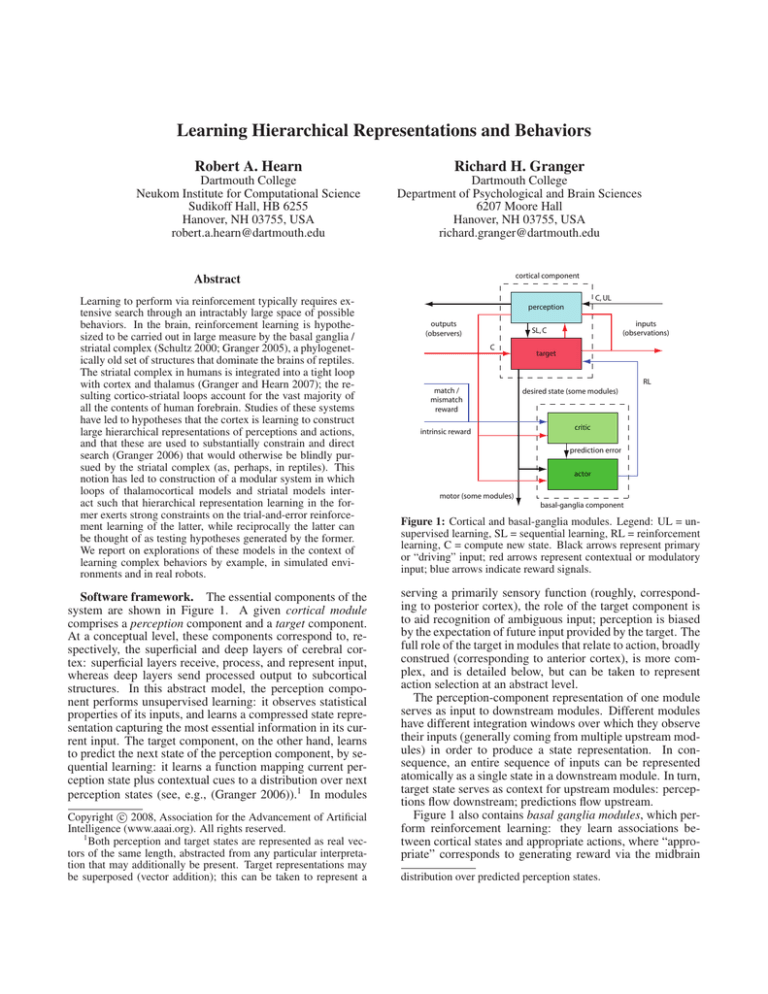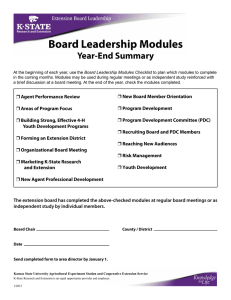
Learning Hierarchical Representations and Behaviors
Robert A. Hearn
Richard H. Granger
Dartmouth College
Neukom Institute for Computational Science
Sudikoff Hall, HB 6255
Hanover, NH 03755, USA
robert.a.hearn@dartmouth.edu
Dartmouth College
Department of Psychological and Brain Sciences
6207 Moore Hall
Hanover, NH 03755, USA
richard.granger@dartmouth.edu
cortical component
Abstract
Learning to perform via reinforcement typically requires extensive search through an intractably large space of possible
behaviors. In the brain, reinforcement learning is hypothesized to be carried out in large measure by the basal ganglia /
striatal complex (Schultz 2000; Granger 2005), a phylogenetically old set of structures that dominate the brains of reptiles.
The striatal complex in humans is integrated into a tight loop
with cortex and thalamus (Granger and Hearn 2007); the resulting cortico-striatal loops account for the vast majority of
all the contents of human forebrain. Studies of these systems
have led to hypotheses that the cortex is learning to construct
large hierarchical representations of perceptions and actions,
and that these are used to substantially constrain and direct
search (Granger 2006) that would otherwise be blindly pursued by the striatal complex (as, perhaps, in reptiles). This
notion has led to construction of a modular system in which
loops of thalamocortical models and striatal models interact such that hierarchical representation learning in the former exerts strong constraints on the trial-and-error reinforcement learning of the latter, while reciprocally the latter can
be thought of as testing hypotheses generated by the former.
We report on explorations of these models in the context of
learning complex behaviors by example, in simulated environments and in real robots.
Software framework. The essential components of the
system are shown in Figure 1. A given cortical module
comprises a perception component and a target component.
At a conceptual level, these components correspond to, respectively, the superficial and deep layers of cerebral cortex: superficial layers receive, process, and represent input,
whereas deep layers send processed output to subcortical
structures. In this abstract model, the perception component performs unsupervised learning: it observes statistical
properties of its inputs, and learns a compressed state representation capturing the most essential information in its current input. The target component, on the other hand, learns
to predict the next state of the perception component, by sequential learning: it learns a function mapping current perception state plus contextual cues to a distribution over next
perception states (see, e.g., (Granger 2006)).1 In modules
c 2008, Association for the Advancement of Artificial
Copyright Intelligence (www.aaai.org). All rights reserved.
1
Both perception and target states are represented as real vectors of the same length, abstracted from any particular interpretation that may additionally be present. Target representations may
be superposed (vector addition); this can be taken to represent a
C, UL
perception
outputs
(observers)
inputs
(observations)
SL, C
C
target
RL
match /
mismatch
reward
intrinsic reward
desired state (some modules)
critic
prediction error
actor
motor (some modules)
basal-ganglia component
Figure 1: Cortical and basal-ganglia modules. Legend: UL = unsupervised learning, SL = sequential learning, RL = reinforcement
learning, C = compute new state. Black arrows represent primary
or “driving” input; red arrows represent contextual or modulatory
input; blue arrows indicate reward signals.
serving a primarily sensory function (roughly, corresponding to posterior cortex), the role of the target component is
to aid recognition of ambiguous input; perception is biased
by the expectation of future input provided by the target. The
full role of the target in modules that relate to action, broadly
construed (corresponding to anterior cortex), is more complex, and is detailed below, but can be taken to represent
action selection at an abstract level.
The perception-component representation of one module
serves as input to downstream modules. Different modules
have different integration windows over which they observe
their inputs (generally coming from multiple upstream modules) in order to produce a state representation. In consequence, an entire sequence of inputs can be represented
atomically as a single state in a downstream module. In turn,
target state serves as context for upstream modules: perceptions flow downstream; predictions flow upstream.
Figure 1 also contains basal ganglia modules, which perform reinforcement learning: they learn associations between cortical states and appropriate actions, where “appropriate” corresponds to generating reward via the midbrain
distribution over predicted perception states.
dopamine system in real brains. In this model, the basal
ganglia modules operate by training the cortical-module target components, also providing random exploratory inputs
at times. Some cortical modules are “primary motor” modules and are connected directly to effectors. In those, target
representation is fixed; target state directly specifies motor
output. Thus, prediction becomes command. When inappropriate commands are generated in a given context, the
associated basal-ganglia modules train the target to select a
different state in the future. Over time, appropriate actions
are learned in varied contexts.
Goal bootstrapping. Primary rewards represent built in
targets such as sleep, satiation, etc.; reinforcement learning
enables the system’s own predictions to define novel rewards
at a more abstract level. The system then bootstraps itself
into automatically representing a goal hierarchy. When a
given “action”-oriented module happens to perceive a current state that matches its predicted target, a reward is generated for lower-level modules that were responsible for generating the actions that led to that perception. This rule has
the effect of transforming the role of target in action modules
into action selection at varying levels of abstraction. Thus,
prediction becomes command, at an abstract level: a module
can effectively select a “goal” state based on its current context, trained by basal-ganglia modules, and trust that other
modules will act so as to achieve that state.
Learning-algorithm selection. The basic model outlined above is agnostic as to the specific unsupervised, sequential, and reinforcement learning algorithms used. In
our computational experiments so far we have used many
standard algorithms, including: self-organizing maps, kmeans clustering, and series of nets of winner-take-all clusters for unsupervised learning; linear associators for sequential learning; and actor-critic versions of temporal-difference
learning for reinforcement learning. These are all intended
as tests of how these mechanisms may behave when embedded in an appropriate large-scale brain architecture.
Typical representations used in reinforcement learning are
non-hierarchical, and thus do not richly represent relations
among concepts. Recent work on “hierarchical reinforcement learning” attempts to address this shortcoming by applying reinforcement methods to hierarchically structured
domains (Precup and Sutton 1998; Andre and Russell 2002).
The work we describe here extends and elaborates this direction via its focus on the learning of the hierarchical representations themselves.
Computational experiments. We have used the above
architecture to teach an AIBO robot dog to stand up from
arbitrary initial postures (Hearn and Granger 2007). This is
a standard task of known difficulty, which is far from trivial
given the size of the search space. What the system learns
is to perform a sequence of small motions that eventually
leads to a standing posture, from any starting posture, such
that each individual motion is within the physical capability
of the servomotors from that configuration.
This system embodies the ideas outlined above, using a
hierarchy of six cortical modules. Primary sensory information from the robot is relayed wirelessly to the computer running the simulation, and drives the state of the S1 module.
S1 states are clustered into more abstract unified representations in the downstream module S2. Primary motor modules drive the front and rear legs; target states are relayed
wirelessly to the robot servos. Downstream of all of these
is a “posture” module that represents a combination of sensory and motor state. Finally, a further downstream “planning” module is hard-coded to represent a desired standing
posture. As the system runs, it first learns abstract representations of posture. When, by chance, the overall posture
more closely matches a standing posture, the current target
mapping in the posture module is rewarded. In turn, when
the current posture matches the target posture, whatever that
may be, the front and rear leg modules reward their current
target mapping—it was that mapping that led to the motor
acts making the posture perception match posture target.
Eventually, the system learns to select a series of highlevel postural targets that will result in a standing posture;
the front and rear legs learn the appropriate steps to transition from one posture to the next. The significance of this application is that a general-purpose architecture for learning
hierarchical state representations and behaviors was used.
Work is in progress on a broad array of applications involving learning to produce motor outputs that reproduce aspects of perceived inputs. In each case, the goal is to enable
learning of appropriate representations, and to match motor representations to sensory representations. The system is
intended to model how humans and other animals perform
these tasks, and, it is hoped, to identify a general system for
achieving perceptual-motor learning from example.
Conclusion. Traditional approaches to building intelligent systems have used constraints from psychology and behavior; it is hoped that adding serious constraints from the
architecture and operating rules of the only existing intelligent systems (brains) may aid in the search for intelligent
systems that work. We proffer one example in the form
of systems that combine a type of reinforcement learning,
a la the brain’s striatal system, with construction of coherent representations of the space being explored, via models of the brain’s thalamocortical system. The integration of
these systems results in a coherent model that incorporates
trial and error search but becomes increasingly directed by
growing semantic knowledge. The model’s components, architecture, and integration correspond to the brain’s largest
regular architectural structure, the cortico-striatal system.
References
Andre, D., and Russell, S. J. 2002. State abstraction for programmable reinforcement learning agents. In Eighteenth national
conference on Artificial intelligence, 119–125. Menlo Park, CA,
USA: American Association for Artificial Intelligence.
Granger, R. H., and Hearn, R. A. 2007. Models of thalamocortical
system. Scholarpedia 2(11):1796.
Granger, R. H. 2005. Brain circuit implementation: Highprecision computation from low-precision components.
In
Berger, T., and Glanzman, D., eds., Replacement Parts for the
Brain. MIT Press. 277–294.
Granger, R. 2006. Engines of the brain: the computational instruction set of human cognition. AI Mag. 27(2):15–32.
Hearn, R. A., and Granger, R. H. 2007. Basal-ganglia-inspired
hierarchical reinforcement learning in an AIBO robot. Demonstration at Neural Information and Processing Systems 2007.
Precup, D., and Sutton, R. S. 1998. Multi-time models for temporally abstract planning. In Advances in Neural Information Processing Systems 10. MIT Press.
Schultz, W. 2000. Multiple reward signals in the brain. Nat. Rev.
Neurosci. 1(3):199–207.




